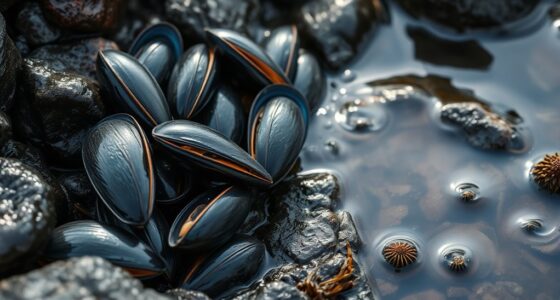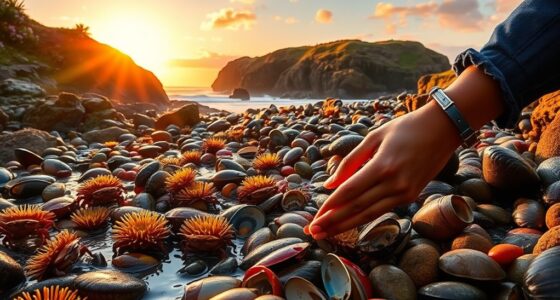To gear up for coastal foraging, you’ll need waterproof baskets, tides tables, and mesh bags to gather and transport your finds. Bring along crab snares, lobster gauges, and sharp knives for harvesting seafood sustainably. Protect yourself with waterproof boots, gloves, wetsuits, and snorkel gear for underwater exploration. Safety accessories like dive flags and float lines help keep you secure. Keep exploring further to discover how to tailor your equipment for every shoreline adventure.
Key Takeaways
- Waterproof baskets, mesh bags, and tide tables facilitate effective, eco-friendly collection and optimal foraging timing.
- Crustacean snares, lobster crooks, and measuring tools support sustainable harvesting of shellfish and prevent undersized catches.
- Protective gear like waterproof boots, gloves, wetsuits, and dive masks ensure safety and comfort during shoreline and underwater exploration.
- Underwater foraging supplies such as fins, snorkels, and specialized tools enable efficient shellfish collection and underwater mobility.
- Safety accessories including dive flags, float lines, and utility knives enhance visibility, security, and quick access during coastal foraging.
Essential Coastal Foraging Tools
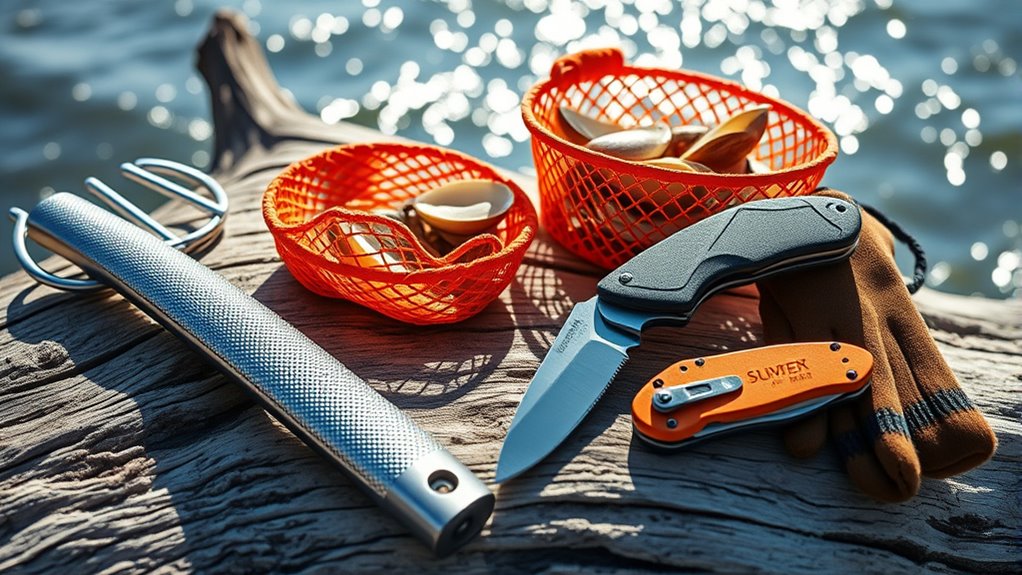
To have a successful coastal foraging trip, you need the right tools to gather and harvest safely. Coastal foraging tools like waterproof baskets made of wicker or seagrass are perfect for collecting your treasures because they’re durable and eco-friendly. Tide tables are essential for planning your trip around the best times, giving you accurate info on tide heights and timings. Mesh bags help you carry your finds while draining excess water, keeping everything organized. Crustacean snares or lobster crooks are specialized tools for catching crabs and lobsters efficiently. Incorporating traditional foraging techniques can enhance your success and sustainability during your trip. Alongside these, waterproof shoes, gloves, and small knives make harvesting safe and straightforward. With these tools, you’re well-equipped to enjoy a productive, safe, and eco-conscious coastal foraging experience.
Measuring and Harvesting Equipment

Accurate measuring and effective harvesting tools are essential for ensuring your foraging complies with local regulations and promotes sustainability. Measuring tools like lobster gauges and crab rulers help you avoid harvesting undersized seafood, supporting sustainable foraging. Harvesting equipment such as oyster shuckers, seaweed scissors, and precision knives like Hori Hori or field knives make collecting coastal plants and shellfish safer and more efficient. Mesh foraging bags with drainage holes are perfect for carrying your catch and cleaning it directly from the shoreline or underwater. Using the right seafood tools and harvesting equipment not only improves your efficiency but also minimizes environmental impact, helping preserve marine and coastal ecosystems for future foragers. Properly selecting sustainable foraging practices can also safeguard your transactions when selling your foraged goods, ensuring secure and reliable sales. Incorporating appropriate tools for safe collection can further enhance responsible foraging habits and reduce damage to delicate habitats. Additionally, choosing tools that are designed for delicate habitats helps protect the fragile ecosystems you are harvesting from. Implementing proper handling techniques further ensures the health of marine species and supports ecological balance.
Protective Gear for Shoreline Adventures

Having the right protective gear guarantees you can forage along the shoreline safely and comfortably. Protective gear like waterproof boots or wellies shield your feet from sharp rocks, shells, and marine hazards. Gloves protect your hands from prickly plants, rough shells, and stings from creatures like jellyfish or sea urchins. A wetsuit or neoprene clothing offers thermal insulation and protection in cold, wet conditions. Essential safety equipment such as dive masks, fins, and snorkels allow safe underwater exploration, reducing fatigue and maximizing visibility. To visualize, consider this table:
| Gear | Purpose |
|---|---|
| Waterproof boots | Prevent injuries from sharp objects on the shoreline |
| Gloves | Safeguard hands from marine hazards |
| Wetsuit | Keep warm and protected during water activities |
| Safety equipment | Enhance underwater safety and visibility |
Additionally, understanding marine hazards can help you better prepare and avoid potential dangers while foraging. Being aware of local regulations ensures your foraging activities remain sustainable and legal. Familiarity with coastal ecosystem dynamics can further improve safety and success during shoreline adventures.
Underwater Foraging and Diving Supplies
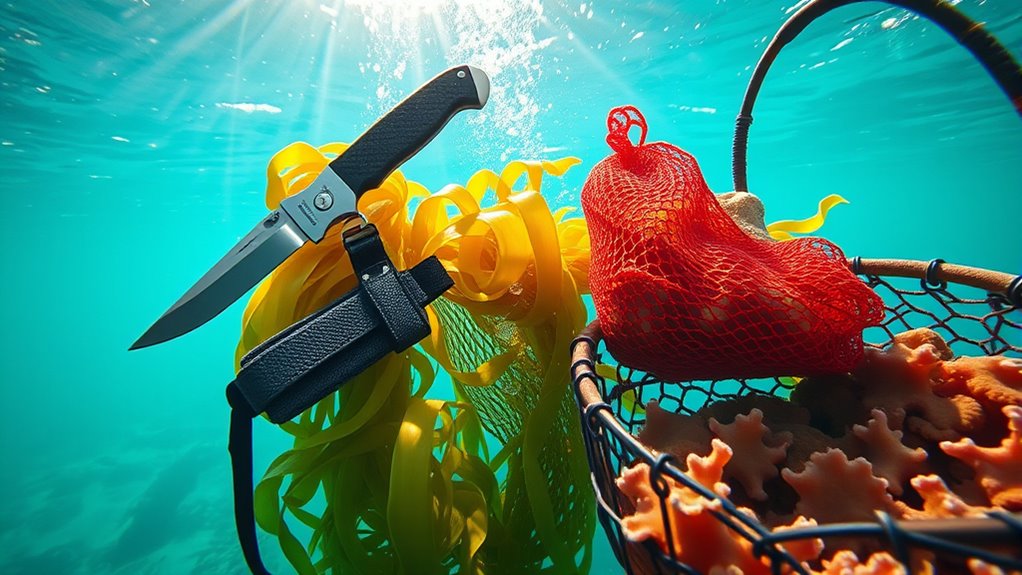
Underwater foraging demands specialized equipment that guarantees both safety and efficiency during dives. Your diving supplies should include wetsuits, masks, snorkels, and fins to help you move comfortably and see clearly beneath the surface. Crustacean-catching tools like lobster crooks, crab extractors, and snares are essential for retrieving shellfish from rocky crevices. Mesh foraging bags with drainage keep your catch secure and water-free, making transport easier. Safety gear, such as dive flags, float lines, and wetsuit gloves, enhances visibility, secures your catch, and protects you from stings and abrasions. Proper underwater foraging tools and supplies are vital for maximizing your catch, maintaining safety, and reducing environmental impact during your coastal diving adventures. Additionally, selecting the right fishing equipment can improve your success rate and ensure a more enjoyable foraging experience. Investing in appropriate gear that is tailored for the specific conditions of your foraging area can further increase efficiency and safety. Furthermore, choosing equipment with quality construction ensures durability and reliable performance during prolonged use. Incorporating ergonomic designs into your gear can also reduce fatigue and improve maneuverability during extended dives, especially when combined with advanced materials that enhance comfort and longevity.
Safety Accessories and Utility Items
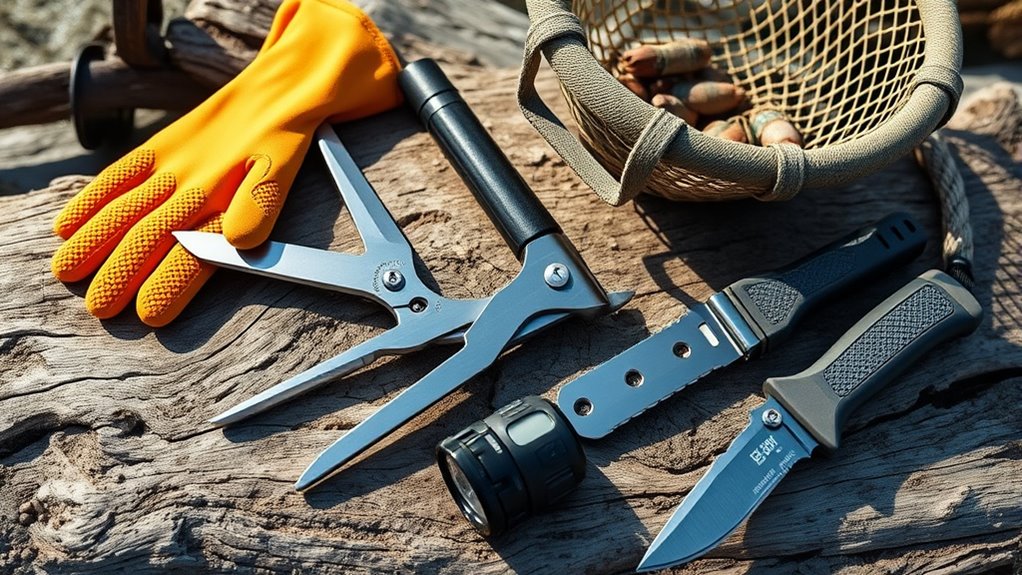
Safety accessories and utility items are essential for a secure and efficient coastal foraging experience. Diver safety gear like dive flags, float lines, and underwater safety equipment help alert boaters and keep you visible, reducing risks. Mesh foraging bags with drainage keep your catch fresh, prevent water buildup, and minimize slipping. Utility dive tools such as dive knives and arm straps secure your equipment, offering quick access and preventing loss. Safety accessories for coastal foraging, including wetsuit gloves, socks, buoyancy aids, and dive lines, enhance your safety by providing warmth, buoyancy, and secure attachment points. These tools ensure you can focus on your foraging with confidence, knowing you’re protected and well-equipped for any underwater situation. Incorporating automation technologies into your gear can further improve efficiency and safety during your trips. Additionally, modern safety protocols emphasize the importance of remote work for better planning and communication during expeditions, ensuring preparedness and coordination. Staying informed about AI discoveries and integrating innovative solutions can also contribute to safer and more effective foraging adventures.
Frequently Asked Questions
What Equipment Do You Need for Foraging?
When you go foraging along the coast, make sure you have the right equipment. You’ll need waterproof baskets or mesh bags to carry your finds, and tide tables to time your trip with low tide. Wear waterproof boots and gloves to stay safe from sharp shells and rocks. Bring a small knife or scissors for harvesting, plus safety gear like a whistle and weatherproof notebook to keep track and stay safe.
Conclusion
With the right tools and gear, you’re unstoppable on the shoreline! You’ll conquer waves, outsmart sea creatures, and harvest treasures like a legendary coastal explorer. Whether you’re measuring, diving, or staying safe, these tools turn ordinary foraging into an epic adventure. So gear up, embrace the wild shoreline, and prepare to find treasures more astonishing than you ever imagined—because with these supplies, you’re practically a coastal legend in the making!



